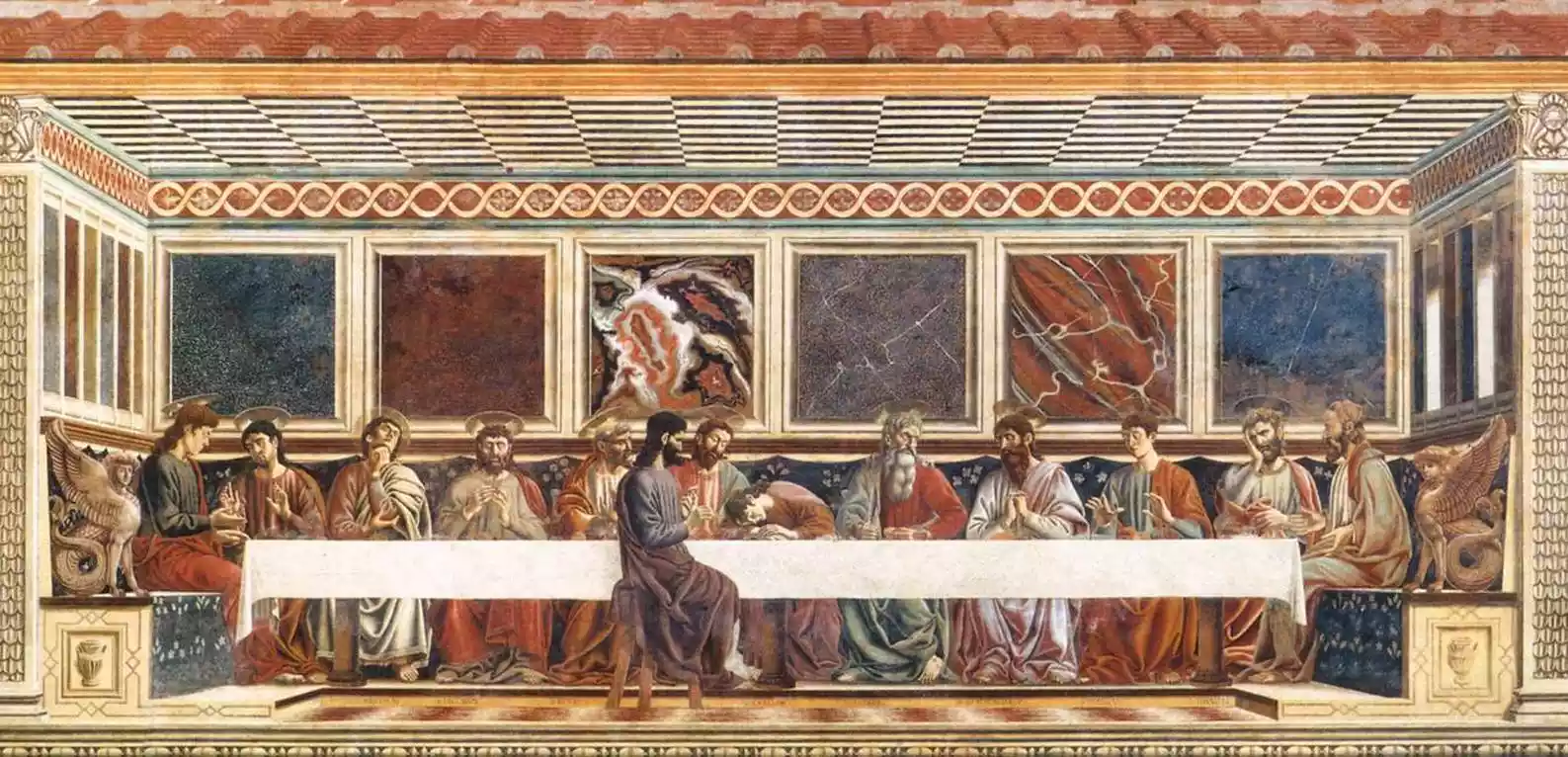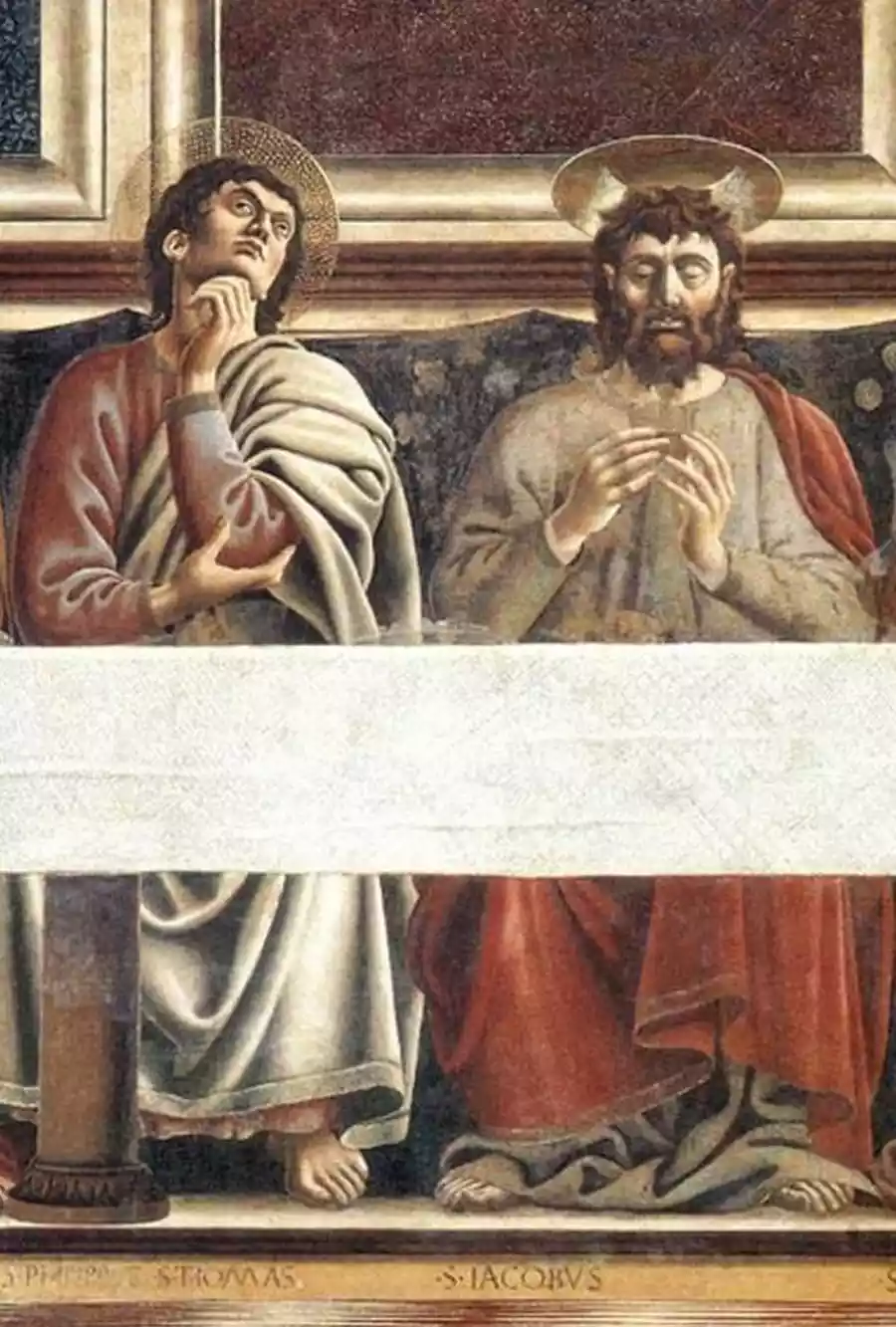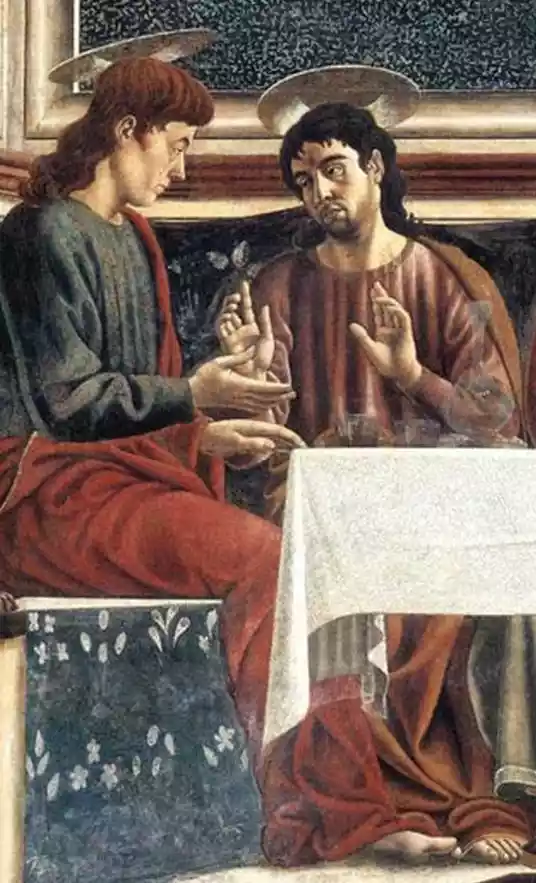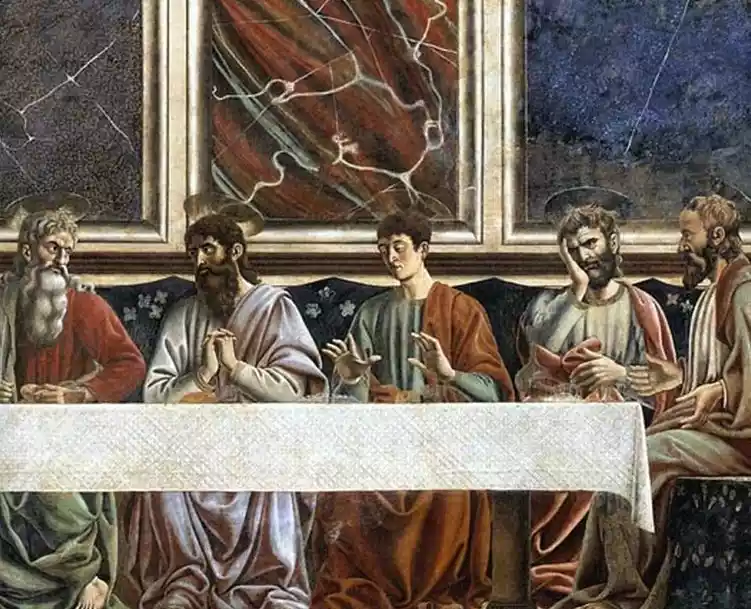
“The Last Supper,” by Andrea del Castagno, stands as a monumental testament to the lasting artistic vitality of the Italian Renaissance—a period not just of artistic beauty but of groundbreaking innovations and a renewed interest in the classical world. The work dates from 1447, and though Castagno’s life was tragically short (he was born in 1419 and died in 1457), he left a palpable mark on Florence’s art scene. The painting now resides within the calm confines of the Florentine monastery of Sant’Apollonia, a suitable home for such a powerful rendering of this momentous event in Christian history. Castagno handles color, light, and perspective with a confidence that seems almost preordained for an artist of the 1440s—one who has been situated halfway between the death of Giotto and the flowering of oil painting in Venice. The work demonstrates a deep understanding of traditional religious iconography, and yet it also seems to partake in some of the artistic innovations of the period—especially those involving the use of linear perspective. Indeed, its contrasts in color and light, together with its carefully calculated rendering of space, almost dictate a new and more intimate way of “reading” the Supper.
The Life and Work of Andrea del Castagno
Andrea del Castagno, a pivotal figure in the early Italian Renaissance, stands as a testament to the transformative power of art and its ability to capture the spirit of an era. His life story, intertwined with the burgeoning cultural and social shifts of 15th-century Italy, provides a fascinating backdrop to his artistic achievements. Castagno’s legacy extends far beyond his own lifetime, his influence resonating through the centuries and shaping the course of Western art. Among his impressive body of work, “The Last Supper” shines as a masterpiece, a culmination of his artistic explorations and a powerful expression of his unique vision. This iconic fresco not only showcases Castagno’s mastery of technique but also reveals his profound understanding of human emotion and his ability to convey complex narratives through visual imagery. It is a work that continues to captivate and inspire, inviting viewers to contemplate its rich symbolism and appreciate the genius of its creator. Consider the context of the early Renaissance, a period of intellectual and artistic ferment, where artists like Castagno were breaking free from the constraints of the past and forging new paths in the representation of the human form and the natural world. His work reflects this spirit of innovation, pushing the boundaries of what was possible in painting and contributing to the broader cultural transformation of the Renaissance. Just as the Renaissance saw a renewed interest in classical learning and the rediscovery of ancient texts, so too did it witness a resurgence of artistic creativity, with artists like Castagno drawing inspiration from the art of antiquity while simultaneously developing their own unique styles. His “Last Supper,” with its dramatic composition and its realistic portrayal of the apostles, exemplifies this fusion of tradition and innovation, capturing the essence of the Renaissance spirit.
Early Years and Artistic Education
Starting in rural Castagnolo, located in Tuscany, Andrea del Castagno became a master of the Renaissance. He grew up in a small town with nothing but the rustic rolling hills to accompany him, but it was there that the young Castagno discovered his painting talent. His family must have encouraged him to go on with his artistically inspired life because they sent him to Florence, then the dynamic home of artistic innovation that was and is still recognized as the epicenter of the Renaissance. The vibrant city was a town in which one could achieve nothing but artistic greatness. Castagno worked and lived in Florence, where he is said to have had a rigorous Master alongside him. While in Florence, he took on the studies of engraving and painting, shining brightly and boldly working towards becoming an artist of great significance.
Castagno’s early works demonstrate an acute eye for detail and a profound fascination with the natural world. He observed closely the play of light and shadow, the textures of things, the subtle, almost imperceptible distinctions in form, and he sought nothing less than to render the reality of nature in his paintings. This striving for realism is something for which Renaissance artists from the 1400s are generally credited. Quite simply, these artists were fascinated with nature, and this fascination with the natural world and incredible detail is something that typifies Castagno and sets him apart from the International Style that preceded him. Although he is not as well known today as some of his contemporaries, like Botticelli or Ghirlandaio (two artists Castagno greatly admired), he enjoyed a unique reputation in Renaissance Florence. Female figures idealized with incredible precision can be found in Castagno’s works (see Mary and Eve in the mural panels at the Badia Fiorentina). Castagno was also fascinated with the male figure, and his paintbrush is perhaps one of the best ever in human history for rendering the figure of Christ.
As Castagno’s stature rose, he was awarded high-profile commissions to decorate churches and palaces all over Florence. These appointments offered him extremely helpful practice in putting together paintings of huge dimensions. More than that, they gave him new opportunities to show off the sort of brainy, head-turning visual effects he liked to create. With every commission, he seemed to get a little closer to what would become, in the eyes of many, his supreme achievement: The Last Supper. When he painted it, an artistic event took place. The event was so great that it occasionally prompts the question, “What is the Last Supper?” The Last Supper is such an occasion artistically that folks often act like it isn’t very humanly possible to put every part of this monumentally big work together and get it achieved on the level it seems to have occurred on.
Significant Works and Legacy
Beyond the famous Last Supper, Castagno created numerous notable works that established his reputation. Portraits of famous Florentines, such as Dante and Petrarch, highlight his ability to capture the essence of human character. His frescoes in the Villa Carducci, with dynamic depictions of heroes and heroines, are a milestone in the evolution of monumental Renaissance painting.
The Last Supper, however, remains Castagno’s magnum opus. This fresco, located in the monastery of Sant’Apollonia in Florence, is a masterpiece of technique and symbolism. Eva-Maria Lundin, in her study “A Renaissance Audience Considered: The Nuns at S. Apollonia and Castagno’s Last Supper,” analyzes the significance of the work in the context of monastic life, offering a new perspective on its function (Lundin).
Castagno’s legacy extends beyond his works themselves. His innovative approach to depicting space and the human form deeply influenced later artists. His technique in the use of perspective and his ability to create illusions of three-dimensional space on flat surfaces opened new paths in Renaissance art.
Andrea del Castagno, through his life and work, emerges as an iconic figure of the Italian Renaissance. His artistic journey, from the early years of his education to the creation of the Last Supper, reflects the artistic and spiritual quests of an era in transition. The Last Supper, as the crowning achievement of his work, continues to intrigue scholars and inspire artists, serving as a timeless symbol of Renaissance art.
Analysis of the Last Supper
The Last Supper by Andrea del Castagno, a work that captivates the eye and challenges the mind, stands as one of the most iconic creations of the Italian Renaissance. This fresco, adorning the monastery of Sant’Apollonia in Florence, is a multi-layered masterpiece that combines technical perfection with deep symbolism.
Iconographic Elements and Symbolism
The composition of Castagno’s Last Supper impresses with its complexity and richness of iconographic elements. At the center of the scene, Christ sits majestically, surrounded by his twelve disciples. The arrangement of the figures is not random; each apostle is strategically placed, reflecting their significance and role in the biblical narrative.
Particular attention is given to the depiction of Judas. Castagno, in an innovative approach, places him on the same side of the table as the other apostles, yet separates him through his body posture and expression. This choice creates intense psychological tension, underscoring the dramatic irony of the scene.
The symbolism extends to the details of the surrounding space. The marble wall in the background, decorated with colorful patterns, is not merely a decorative element but serves as a kind of spiritual mirror, reflecting the sanctity of the moment.
Andrea del Castagno’s Last Supper and the Technical Innovations of the Work
In Andrea del Castagno’s “The Last Supper,” the artist’s technical virtuosity shines through, captivating the viewer and drawing them into the heart of this pivotal biblical scene. His masterful application of linear perspective is particularly striking, creating an illusion of depth so compelling that the viewer feels almost as if they are present within the very room where the Last Supper took place. The vanishing point, cleverly positioned at the center of the composition, aligns perfectly with Christ’s head, subtly emphasizing his divine presence and drawing the viewer’s eye to the central figure of the narrative. This strategic use of perspective not only adds a sense of realism to the scene but also serves to underscore the spiritual significance of the event.
Castagno’s innovative use of light and shadow further enhances the dramatic impact of the fresco. The stark contrasts between brightly illuminated areas and deep shadows create a palpable sense of drama, heightening the emotional intensity of the scene. This technique, known as chiaroscuro, adds a three-dimensional quality to the figures and objects, emphasizing their volume and texture. The play of light and shadow also contributes to the overall composition, guiding the viewer’s gaze and highlighting key elements of the narrative. This masterful manipulation of light anticipates the dramatic effects that would later become a hallmark of Baroque painting, demonstrating Castagno’s forward-thinking approach to artistic technique.
Beyond his technical prowess, Castagno’s “Last Supper” also reveals his profound understanding of human nature. Each apostle is depicted with distinct facial features, expressive gestures, and individualized personalities, reflecting the Renaissance emphasis on humanism and the celebration of individual potential. The artist’s meticulous attention to detail extends to the rendering of the garments, where the folds and drapery are depicted with remarkable accuracy. This attention to detail, combined with his anatomical precision, testifies to Castagno’s deep understanding of the human form and his ability to translate his observations of the natural world into compelling works of art. Consider the scientific advancements of the Renaissance, with figures like Leonardo da Vinci dissecting human bodies to better understand their workings. This same spirit of inquiry and observation is evident in Castagno’s work, where he combines artistic skill with a keen understanding of the human form and the world around him. His “Last Supper” is not just a religious image; it is a testament to the power of human observation, artistic innovation, and the enduring legacy of the Renaissance.
Color Palette and Composition
Andrea del Castagno’s “The Last Supper” is a vibrant tapestry of color and composition, a visual feast that captures the emotional and spiritual intensity of this pivotal biblical event. The artist’s bold color palette, dominated by rich reds, deep blues, and verdant greens, creates a sense of dynamic energy, reflecting the dramatic undercurrents of the scene. These intense hues, far from being arbitrary, are imbued with symbolic meaning, each color contributing to the overall emotional impact of the fresco. The sparing use of gold, a precious and luminous metal, adds a touch of divine splendor, particularly in the depiction of Christ, subtly highlighting his sacred status within the gathering of his followers. This strategic use of gold elevates the spiritual dimension of the work, reminding the viewer of the profound religious significance of the event being portrayed.
The composition of “The Last Supper” is a testament to Castagno’s artistic ingenuity, a complex yet harmonious arrangement of figures and architectural elements. The horizontal expanse of the table acts as a central axis, around which the drama of the Last Supper unfolds. This linear element anchors the composition, providing a sense of stability amidst the emotional turmoil of the scene. The vertical lines of the marble decorations in the background create a strong visual framework, enhancing the illusion of depth and providing a sense of architectural grandeur. These vertical elements not only add to the overall aesthetic of the fresco but also serve to direct the viewer’s gaze, guiding their eyes towards the central figures and key details of the narrative.
One of the most intriguing aspects of Castagno’s composition is his masterful use of negative space. The artist deliberately leaves gaps between the figures, creating pockets of emptiness that allow the viewer’s eye to rest and contemplate the scene. This strategic use of space not only enhances the sense of depth and perspective but also contributes to the overall emotional impact of the work. The empty spaces seem to isolate each apostle, emphasizing the uniqueness of their individual experiences and their personal reactions to the events unfolding before them. This sense of isolation adds a layer of psychological complexity to the fresco, inviting the viewer to consider the inner turmoil and spiritual reflections of each disciple.
Andrea del Castagno’s “The Last Supper” remains a source of endless fascination, a work that continues to inspire awe and provoke thoughtful discussion. Through its exceptional technical execution, its rich symbolism, and its innovative approach to composition and color, this fresco stands as a towering achievement of the Renaissance. It is not only a milestone in the history of art but also a timeless masterpiece that offers profound insights into the human condition and the enduring power of faith. Just as the Renaissance saw a renewed interest in the art and philosophy of classical antiquity, so too did it witness a flourishing of artistic innovation, with artists like Castagno pushing the boundaries of their craft and exploring new ways of representing the world around them. “The Last Supper” embodies this spirit of innovation, demonstrating the artist’s mastery of perspective, his understanding of human anatomy, and his ability to convey complex emotions through visual imagery. It is a work that continues to resonate with viewers today, reminding us of the enduring legacy of the Renaissance and the timeless power of art to capture the human spirit.
The Last Supper in the Context of the Renaissance
More than simply a lovely painting, Andrea del Castagno’s “The Last Supper” is a window into the heart of the Renaissance. Its fresco masterpiece resides in the monastery of Sant’Apollonia. It is a chosen work of the spiritual, artistic, and social forces of the Renaissance and, in many respects, is a historical artifact both of the period and for the period that remade Western culture. It is a work that (in the mind of some art historians) embodies the very essence of Renaissance thought. It reflects the renewed interest in classical forms, as seen in its use of dramatic composition and human figures. It is a work that speaks to some of the very fundamental artistic changes between the Middle Ages and the Renaissance. It is a chosen item for the theme of art that is human-centric and emotionally resonant. It is an even more chosen item for the theme of art and science, as it uses perspective (to some the ne plus ultra of the Renaissance fascination with realism) to create a believable setting for what is basically a stage play for the audience.
Religious and Social Significance
The Last Supper, as a theme, held a central place in the Christian iconography of the Renaissance. However, Castagno’s approach goes beyond the mere representation of a religious event. The artist incorporates elements into his work that reflect the social and spiritual concerns of his time.
The depiction of the apostles as individuals with distinct personalities and emotions reflects the shift towards humanism, a characteristic feature of the Renaissance. At the same time, the detailed rendering of space and objects indicates the new emphasis on observation and accurate representation of the natural world.
The placement of the work in a monastery adds an additional dimension to its significance. As noted by Hayum, frescoes of the Last Supper in monastic refectories served as points of spiritual meditation for the nuns, linking the daily act of nourishment with the divine communion (Hayum).
Castagno’s Last Supper stands out when compared to other contemporary or later depictions of the same theme. Unlike more traditional approaches, Castagno introduces a dynamic tension in his composition. The use of intense colors and the dramatic arrangement of the figures create an atmosphere of psychological tension absent from more static depictions.Notable is the comparison with the later Last Supper by Leonardo da Vinci. While Leonardo chooses to isolate Judas, Castagno includes him in the group, creating a more complex psychological dynamic. This choice reflects the evolving perception of human nature and the complexity of human relationships. Castagno’s innovative use of perspective and space deeply influenced later artists. The creation of an illusory space that extends beyond the physical boundaries of the wall opened new paths in the art of fresco painting.
Impact on Later Art
The influence of Castagno’s Last Supper on later art is undeniable. The bold use of color and dynamic composition had a significant impact on artists of the Late Renaissance and Mannerism. Castagno’s ability to combine realism with expressive power set new standards in the depiction of religious themes.
The chiaroscuro technique, which Castagno masterfully applied, was further developed by later artists such as Caravaggio, leading to the development of the tenebrism style. The emphasis on the psychological depiction of characters deeply influenced the evolution of portraiture in subsequent centuries.
Moreover, Castagno’s innovative approach to organizing space and using perspective opened new paths in the art of fresco painting. His ability to create the illusion of an expanding space beyond the physical boundaries of the wall significantly influenced the evolution of monumental painting.
Andrea del Castagno’s Last Supper remains a landmark work of the Renaissance, continuing to inspire and intrigue artists and scholars. This composition, with its technical perfection and rich symbolism, serves as a timeless testament to the power of art to transform the religious experience into a profound human experience.
Epilogue
Andrea del Castagno’s “The Last Supper” stands as a monumental achievement of the Italian Renaissance, encapsulating the era’s fervent artistic and spiritual explorations. This remarkable fresco, housed in the monastery of Sant’Apollonia in Florence, makes an event from the Bible anything but just a depiction. Castagno’s masterful manipulation of perspective, color, and composition creates a scene of breathtaking realism and dramatic intensity. The viewer is not simply witnessing the Last Supper; they are drawn into the event’s emotional core, experiencing its weight with the apostles. Quiet contemplation dances on the edge of anxiety and a few sardonic smiles with the mightiest of these human figures—Judas, who, not without pleats and folds elsewhere, has a look of barely-contained torment and who has just reached the midpoint in a plenteous double-cross. This is obviously a moment laced with imminent violence, with all of these apostles on the verge of jumping up like so many action figures, no longer content to lie down in their parts. Nowhere does Castagno, who anyway seems to have rather missed the mark in not emphasizing Jesus as the moment’s figurehead, reinforce any interpretation of future events leading up to the Crucifixion.
The impact of “The Last Supper” on subsequent art cannot be denied. It carved a path for artists after Castagno to paint religious subjects with greater emotional depth and realism. It also pushed the envelope of the fresco technique. While it serves as a valuable historical document, offering insights into the intellectual and aesthetic currents of the Renaissance, “The Last Supper” endures as one of my favorite works. It embodies the era’s obsession with classical antiquity, its embrace of humanism, and its pursuit of relentless artistic innovation. Just as the Renaissance saw a revival of interest in classical philosophy and literature, so too did it witness a renewed focus on naturalism in painting. Castagno’s “Last Supper” reflects this trend, capturing the physical reality of the scene while also delving into the psychological and spiritual dimensions of the event.
elpedia.gr
Bibliography
- Lundin, Eva-Maria. A Renaissance Audience Considered: The Nuns at S. Apollonia and Castagno’s Last Supper. 2006. University of Georgia, MA Thesis. libs.uga.edu
- Hayum, Andrée. “Last Suppers and their refectories.” The Art Bulletin, 2006, Taylor & Francis. tandfonline.com
- Gilbert, Creighton E. “The pursuit of holiness in Late Medieval and Renaissance.” 1974. Brill. brill.com





